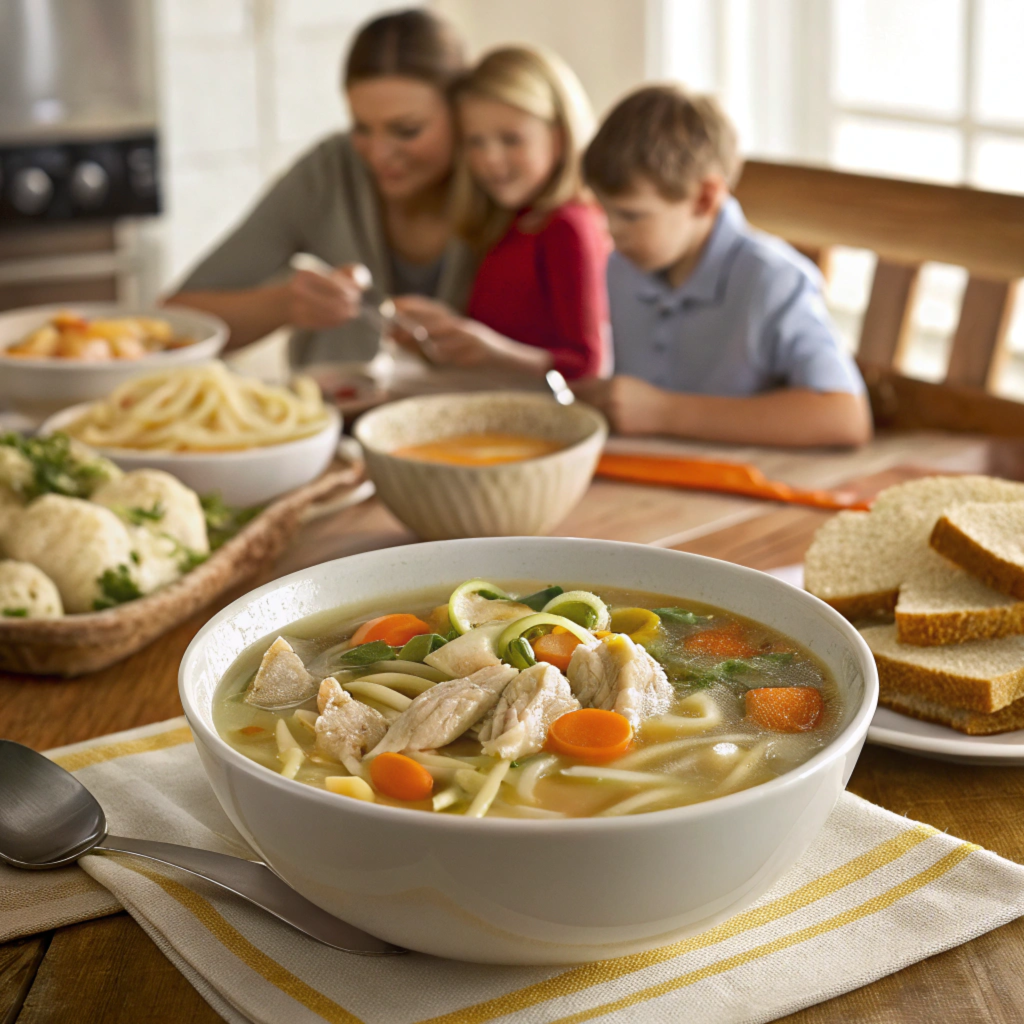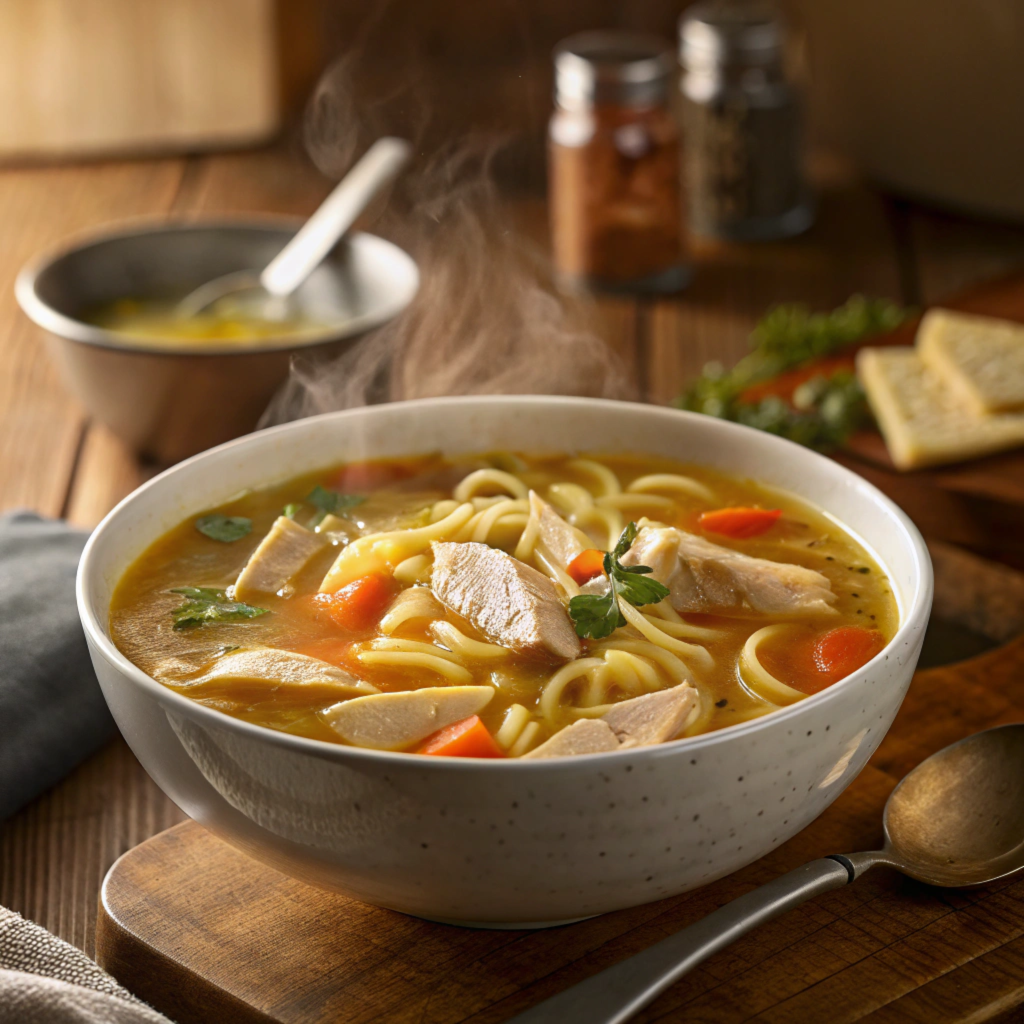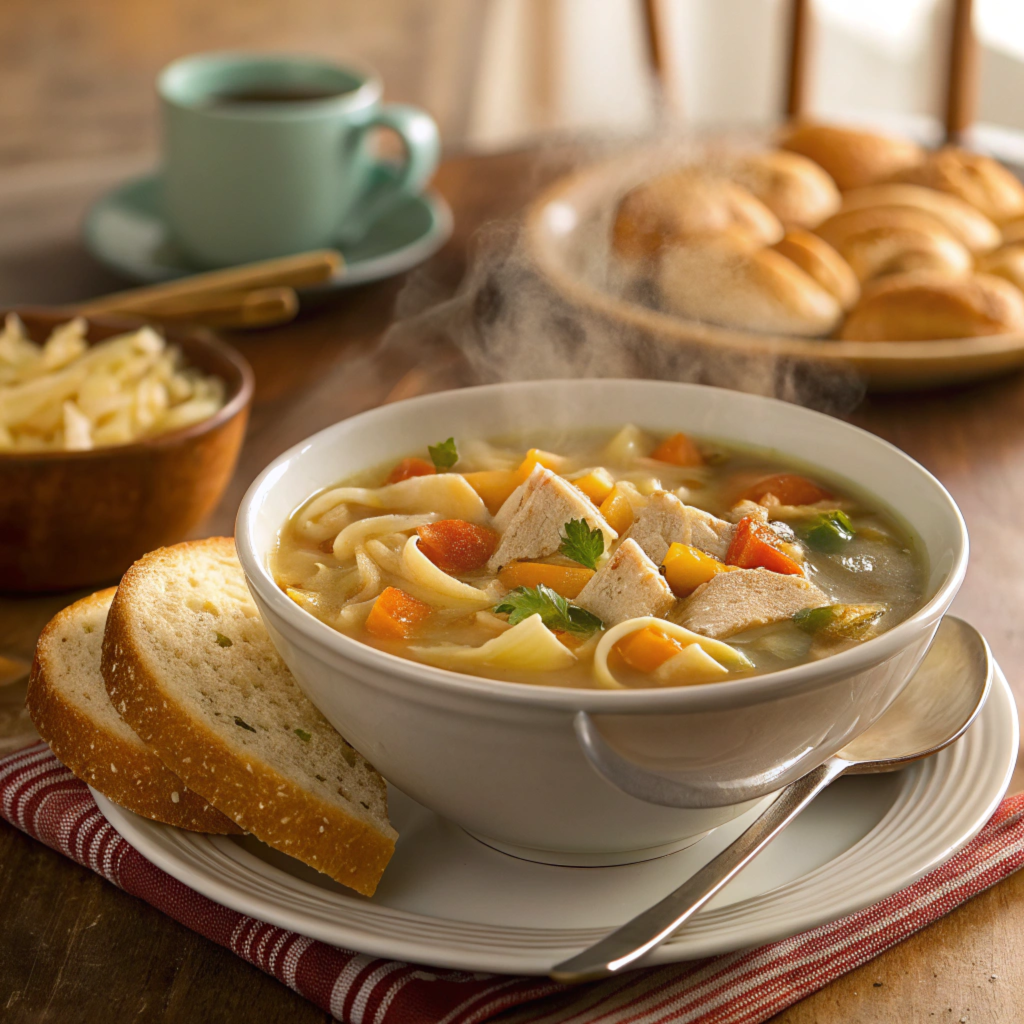
Campbell’s Chunky Chicken Noodle Soup is a popular pantry staple known for its rich flavor and comforting ingredients. However, many consumers wonder: Does Campbell’s Chunky Chicken Noodle Soup have MSG? This question arises due to growing awareness of food additives and health-conscious eating. To provide clarity, let’s explore MSG, its role in processed foods, and how Campbell’s ensures transparency about its ingredients.
Why MSG in Food Is a Concern
Monosodium glutamate, commonly known as MSG, is a flavor enhancer found in many processed and packaged foods. It’s often added to boost savory taste, especially in soups, sauces, and snacks. While MSG is considered safe by the U.S. Food and Drug Administration (FDA), some individuals prefer to avoid it due to perceived health risks, including potential allergic reactions, headaches, or sensitivity to sodium-rich foods.
The concerns about MSG stem from its widespread use in fast food and canned products, which has led consumers to scrutinize labels more closely. Many people seek out MSG-free foods for a cleaner, more natural eating experience.
Understanding MSG’s Role in Processed Foods
MSG works by enhancing the umami flavor, also called the “fifth taste,” which gives savory foods their satisfying depth. It intensifies the flavors of meats, broths, and vegetables, making canned soups like Campbell’s Chunky Chicken Noodle more flavorful. However, in response to health-conscious trends, food manufacturers have developed recipes that reduce or eliminate MSG while maintaining taste quality through alternative ingredients.
Campbell’s Commitment to Transparency
To meet evolving consumer expectations, Campbell’s has improved ingredient transparency by clearly labeling its products. Ingredient lists and nutritional details are accessible on Campbell’s official website and product packaging. This allows customers to easily check if MSG or related additives are present.
Campbell’s has taken proactive steps to reduce artificial additives in many of its soup varieties. The company also offers a range of Healthy Request and Well Yes! soups, which emphasize simple, wholesome ingredients.
Why Knowing the Ingredients Matters
Understanding whether Campbell’s Chunky Chicken Noodle Soup contains MSG helps consumers make better choices based on their dietary preferences. By reading ingredient labels and staying informed, you can enjoy your favorite soups while managing any concerns about MSG or other additives.
What Is MSG and Why Is It Used?
MSG, short for Monosodium Glutamate, is a sodium salt derived from glutamic acid, a naturally occurring amino acid found in many foods. It enhances the savory or “umami” taste of dishes, making them more flavorful and satisfying. Its ability to intensify flavors has made MSG a popular additive in processed foods, including soups, snacks, and sauces.
Definition and Composition
MSG consists of sodium and glutamate, which work together to boost the taste of savory meals. Glutamate is present in many natural foods such as tomatoes, cheese, and mushrooms. When combined with sodium, it becomes a powerful seasoning agent that intensifies the natural flavors of meats and broths.
How It Works in Processed Foods
MSG stimulates taste receptors on the tongue responsible for detecting savory flavors. This process tricks the brain into perceiving that the food is richer and more satisfying than it might be without the additive. Its widespread use in processed foods, including canned soups and packaged snacks, stems from its effectiveness in improving taste without adding extra fat or sugar.
Why Food Companies Use MSG
Food manufacturers use MSG to enhance flavor while keeping production costs low. Adding MSG can create a depth of flavor that otherwise might require more expensive ingredients like real meat or fresh vegetables. This makes it ideal for mass-produced items such as Campbell’s Chunky Chicken Noodle Soup and similar products.
Boosting Umami Flavor in Savory Dishes
The term umami refers to the deep, savory taste that MSG helps create. It is considered the fifth basic taste, alongside sweet, sour, salty, and bitter. MSG enhances the umami flavor in broths, stews, and even snacks, making them more appealing to the taste buds.
Extending Shelf Life in Packaged Foods
Another reason MSG is commonly used in processed foods is its role in preserving flavor during long shelf lives. By intensifying taste, MSG compensates for the natural flavor loss that occurs during canning or packaging. This makes it a valuable ingredient for companies aiming to provide consistently tasty products.
MSG in Home Cooking and Restaurants
Beyond commercial food production, MSG is often used in home cooking and restaurant kitchens. Many Asian cuisines incorporate MSG in popular dishes like ramen, stir-fries, and soups. It is a common seasoning in Japanese and Chinese cuisine due to its ability to enhance bold flavors with minimal effort.
By understanding MSG’s definition, purpose, and role in enhancing taste, consumers can better evaluate the ingredient lists of their favorite products, including Campbell’s Chunky Chicken Noodle Soup. Knowing why MSG is used helps inform smarter choices when selecting pantry staples.
Ingredients in Campbell’s Chunky Chicken Noodle Soup
Understanding the ingredients in Campbell’s Chunky Chicken Noodle Soup can help consumers make informed dietary choices. The brand claims to prioritize quality and flavor while adhering to food safety standards. Let’s explore the key ingredients used in this popular soup and determine whether MSG is present.
Key Ingredients
- Chicken Breast Meat
- Description: Real, tender chicken breast is used as the main protein source.
- Why It’s Included: Provides essential protein while adding heartiness to the soup.
- Egg Noodles (Enriched Wheat Flour)
- Description: Classic egg noodles made from wheat flour, eggs, and water.
- Why It’s Included: Adds filling carbohydrates that make the soup more satisfying.
- Carrots and Celery
- Description: Fresh carrots and celery add crunch, color, and nutrients.
- Why It’s Included: Enhances flavor while providing vitamins and minerals.
- Chicken Broth
- Description: A savory liquid made from simmering chicken bones and vegetables.
- Why It’s Included: Acts as the soup’s base, delivering rich, comforting flavor.
Broth and Seasonings
The broth in Campbell’s Chunky Chicken Noodle Soup contains essential flavorings:
- Salt: Enhances the savory taste of the broth and ingredients.
- Onion Powder: Adds a subtle aromatic depth.
- Garlic Extract: Delivers a mild, savory taste that balances the broth.
These seasonings ensure that every spoonful of soup is flavorful and satisfying.
MSG or No MSG?
According to Campbell’s official ingredient list, MSG is not directly listed as an ingredient in its Chunky Chicken Noodle Soup. However, hidden MSG sources may appear under alternative names, such as:
- Hydrolyzed Vegetable Protein (HVP): A flavor enhancer derived from soy or corn, known for containing free glutamates similar to MSG.
- Yeast Extract: A common additive providing umami flavor, often considered a natural form of MSG.
- Natural Flavorings: These may contain MSG-like components but are labeled differently due to regulatory standards.
Natural Flavor Additives
Campbell’s also uses natural flavorings such as vegetable extracts and herbs. These components contribute to the soup’s balanced taste while supporting the brand’s commitment to clean label transparency.
Checking Ingredient Labels
For health-conscious consumers or individuals sensitive to MSG, reading product labels is essential. Campbell’s regularly updates its ingredient lists on its official website, allowing customers to verify the latest formulations.
Conclusion
While MSG is not explicitly listed in Campbell’s Chunky Chicken Noodle Soup, ingredients like yeast extract and hydrolyzed protein may provide similar flavor-enhancing effects. By knowing what to look for on product labels, consumers can make better decisions based on their dietary preferences and health goals.
Health and Nutrition Considerations
Campbell’s Chunky Chicken Noodle Soup is often seen as a convenient and filling meal option. However, consumers may wonder whether it aligns with their dietary needs. Let’s examine its nutritional content, MSG safety, and how to make healthier choices when enjoying this popular soup.
Is MSG Safe to Consume?
Scientific Findings on MSG Safety
- FDA Classification: The U.S. Food and Drug Administration (FDA) considers MSG “Generally Recognized as Safe” (GRAS).
- Scientific Research: Studies have shown that moderate MSG consumption is safe for most people.
- Misconceptions: Despite its bad reputation, MSG-related symptoms like headaches or bloating have not been consistently proven in clinical trials.
Who Should Be Cautious?
- MSG Sensitivity: Some individuals report sensitivity to MSG, experiencing mild reactions such as dizziness or stomach upset.
- Dietary Restrictions: People following a low-sodium diet should also be cautious, as foods containing MSG may be high in salt.
Health Effects of MSG in Excess
Even though MSG is generally safe, consuming too much can lead to unwanted side effects:
- Increased Sodium Intake: Many products containing MSG also have high sodium content, which can raise blood pressure.
- Potential Side Effects: Frequent overconsumption could cause water retention, bloating, or headaches in sensitive individuals.
Nutritional Breakdown of Campbell’s Chunky Chicken Noodle Soup

Macronutrients per 1 Cup (Approximate Values):
- Calories: ~180-220
- Protein: ~14g from chicken and egg noodles
- Fat: ~3g, mostly from chicken and broth
- Carbohydrates: ~25g, primarily from noodles
- Fiber: ~2g from vegetables
Sodium and Sugar Content
- Sodium: ~890mg (high for low-sodium diets)
- Sugar: ~4g from carrots, celery, and broth
Consumers can manage their sodium intake by choosing low-sodium soup varieties if available.
Low-MSG Alternatives from Campbell’s
Campbell’s offers several product lines designed for health-conscious consumers:
- Healthy Request Line: This line features lower-sodium soups and heart-healthy options certified by the American Heart Association.
- Organic Varieties: Campbell’s organic soups have simpler ingredient lists with fewer artificial additives.
How to Make Healthier Choices
- Read Labels Carefully: Look for low-sodium, MSG-free, or organic options.
- Add Fresh Ingredients: Enhance canned soup with fresh vegetables like spinach, kale, or mushrooms for extra fiber and vitamins.
- Use Homemade Broth: Making soup from scratch gives you full control over sodium and additives.
Final Thought
While Campbell’s Chunky Chicken Noodle Soup is a tasty and convenient meal, balancing its nutritional content with a mindful approach can help maintain a healthy diet. Choosing low-sodium alternatives or enhancing the soup with fresh ingredients can turn a convenient meal into a nutritious option.
Why Check Labels for MSG?
Checking food labels is essential for anyone concerned about consuming MSG or managing their dietary intake. Food products like Campbell’s Chunky Chicken Noodle Soup often contain a variety of ingredients, some of which may be sources of hidden MSG. Here’s how to read labels effectively and make informed choices.
Reading Nutrition Labels
Reading nutrition labels can help consumers quickly spot MSG and other additives:
Look for MSG on Ingredient Lists
- Direct Listing: If MSG is used as an ingredient, it must be explicitly listed on the label.
- Common Names for MSG: Be aware of alternative names like “monosodium glutamate,” “hydrolyzed protein,” or “autolyzed yeast extract.”
- Hidden Sources: Ingredients like “natural flavors,” “seasoning blends,” or “soy protein isolate” can also indicate MSG presence.
Key Nutritional Values to Watch
- Sodium: Choose products with lower sodium content if you’re concerned about heart health.
- Preservatives and Additives: Avoid items with long lists of artificial additives and preservatives.
Contacting the Manufacturer
If the ingredient list is unclear or incomplete, contacting the manufacturer can provide additional details. Here’s how to approach it:
Reaching Out to Campbell’s Customer Service
- Call or Email: Use contact information on the Campbell’s website to request specific ingredient details.
- Check the FAQ Section: Campbell’s frequently updates its FAQ section, addressing concerns like MSG and allergen presence.
Website Transparency
- Official Ingredient Pages: Visit Campbell’s official product page to find detailed nutritional information and ingredient disclosures.
- Product Updates: Sign up for notifications about product changes, including reduced-MSG or organic product launches.
Making Informed Choices
To reduce MSG intake and maintain a balanced diet, follow these tips:
Compare Soup Varieties
- Low-Sodium Soups: Look for soups labeled “low-sodium” or “no added MSG.”
- Organic or Natural Lines: Consider organic options with cleaner ingredient lists.
Consider Homemade Alternatives
- Homemade Soups: Cooking chicken noodle soup at home allows full control over ingredients, ensuring no MSG or preservatives are added.
- Flavor Enhancers: Use herbs like thyme, rosemary, and bay leaves for natural umami flavor.
Why It Matters
Checking food labels empowers consumers to:
- Avoid Hidden Additives: Prevent unintended MSG consumption.
- Manage Dietary Restrictions: Choose suitable products for special diets like low-sodium or gluten-free.
- Ensure Transparency: Support brands committed to clear ingredient labeling and transparency.
By following these steps, you can enjoy your favorite soups while making healthier and more informed dietary decisions.
Key Takeaways
1. Ingredient Transparency

Campbell’s labels clearly indicate when MSG is added. Reviewing the ingredient list can quickly reveal its presence. However, consumers must also watch for less obvious sources like “natural flavors” and “modified food starch.”
2. Health and Nutrition Considerations
While MSG is recognized as safe by health authorities, some people choose to limit its intake due to personal sensitivity or dietary preferences. Selecting Campbell’s low-sodium or organic options can reduce exposure to MSG and other additives.
3. Making Smart Food Choices
Consumers can reduce MSG consumption by:
- Choosing Low-Sodium Soups: These typically contain fewer flavor enhancers.
- Checking Product Labels: Look for clear ingredient listings.
- Cooking at Home: Make homemade chicken noodle soup using natural ingredients like herbs, vegetables, and homemade broth.
Why Label Reading Matters
Staying informed through label reading, contacting manufacturers, and reviewing product websites helps consumers:
- Manage Sodium and Additives: Especially for those with dietary restrictions.
- Avoid Allergens and Sensitivities: Prevent unwanted reactions to ingredients like MSG.
- Support Transparency: Encouraging brands to provide clear ingredient disclosures.
Final Verdict
Does Campbell’s Chunky Chicken Noodle Soup have MSG? The answer depends on the specific product variety. While some Campbell’s soup lines advertise “No Added MSG,” others may still contain it indirectly. By reading labels carefully and considering homemade alternatives, consumers can make better food choices while enjoying this beloved comfort soup.